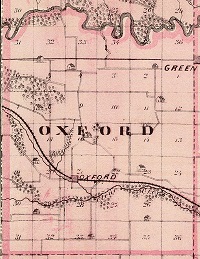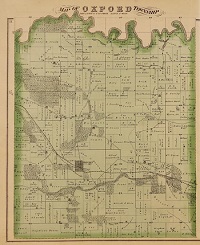The settlement of Oxford township
-
dates
away back in territorial times. The pioneers were James Douglass, Sr.,
Ebenezer Douglass, Charles Marvin, Henry Brown, Bronson Brown, and
William Brown. The Douglasses, Marvin and one of the Browns brought
families; all came in 1839. James Douglass settled on the old Douglass
place; Ebenezer on the Hamilton place, and Marvin on section 24, Oxford
township. The Browns located on the premises now occupied by the farm
of Mr. C. Yenter, where they lived until 1842, when they sold their
claim to Jonathan Talbott, who bought the mill on Clear Creek in 1849,
on the site now occupied by the Stickler factory. In this early period
also came the Hulls, Porter and John, and located near the Douglasses.
John
L. Heartwell, now familiarly known as “uncle John,” also settled in
that locality, but soon returned to Ohio, comping back, however, in
1852, and locating permanently two miles north of the present site of
Oxford, where he lived
till he
became a citizen of the village. In 1841 or 1842, the first business
firm in Oxford township was established just below Dutch lake. The
stock of the firm was a barrel of whiskey, the business dealing it out
to the Indians. The members were Stone, Sprague & Lindley. They
did
not prosper; we are happy to be informed.
A few words relative
to these early settlers will not be amiss. James Douglass always
remained upon the premises where he first located, being the first
postmaster of Copi post-office, established in 1844. His
death
occurred in 1854, and that of his wife, Fannie, in 1879. John, Cyrus,
James, David, and William are his sons.
Ebenezer Douglass
purchased the saw-mill of John Moore in 1853, located just east of
township line. He died in 1854, and left one son, Joseph, now residing
at Tiffin, and one daughter, Mary, wife of H. Hamilton. Aunt Sarah
still survives, living with her daughter, Mrs. Hamilton.
Excepting
a “trail” sometimes passed over by vehicles in procuring furs from the
agency in Iowa county, there were no roads The pioneers made their
roads as they came, following the “divides,” where practicable and when
a stream had to be crossed, it was done by detaching the team and
running the wagon in by hand, and hitching to the end of the tongue and
drawing it out on the other side.
Provisions
enough to last a few weeks were usually brought by the settlers, and
when that was exhausted, a new supply could only be obtained by making
a trip to Illinois, where meal could be obtained, that being the “staff
of life” in those times. And when inclemency of weather, or
other
causes prevented their going down into “Egypt,” other means must be
devised for obtaining breadstuff, and many a time the pioneer has
feasted on corn-cake made of meal ground in a coffee-mill, or pounded
in an iron kettle. Indeed, the settler who owned a “big kettle” was
considered particularly fortunate if he also had a wagon with a big
“king bolt,” the head of which was used in crushing the corn into meal.
One
thing, however, was much to the advantage of the pioneer, for with his
trusty rifle he was sure of a supply of meat, venison and turkey, which
were nearly always a part of the settlers’ meal. Teams going to the
river for supplies brought the mail from Bloomington (Muscatine) and
the settlers did not entirely lose sight of things in the busy world
from which they had separated themselves to lay the foundation for a
new empire.
One thing worthy of mention the writer has observed
about the first settlements here as well as elsewhere, nearly all were
made in the “woods” and often the new settler might be seen painfully
laboring to clear a field in the woods when thousands of acres lay
adjoining which might have been prepared for a crop with one tenth of
the labor required to prepare the woodland. None doubted the fertility
of the soil on the prairies, but the force of habit led him to select
the timber land with all the labor required to clear it off and the
inconvenience of its cultivation afterwards for their beginning.
Orrin
Lewis made a claim and settled where the Remley farm now is. He was
known by the nickname of “Old Specimen,” from a peculiarity of
conversation. He soon sold his claim to James Simpson, who also sold in
a few yeas to Thomas or Thompson. Henry Springmire located where the
Brennans now live, and about 1844, Benjamin Williams located on the
place now occupied by Peter Williams. Mrs. Williams still survives and
is now Mrs. Merritt, well known in Oxford.
Of the neighbors we
might with propriety speak of every one within ten miles, for persons
living at that distance then were regarded as near neighbors. And it
would not take much space to name them all, but we will mention only
those who were well known and remembered. On the east side of Tiffin
were the Spragues and Spicers, and Amosa Doud. Further on were Sam
Huston of the Johnson place, John Headley on the Wolf place,
Gillilands, Keelers and Nathaniel Fellows, down as far as the Isaac
Dennis place. On the south, Burns and Simpson on Old Man’s creek were
nearest and north to one within ten miles, while west the “noble red
man” held undisputed sway, till his removal in 1843.
Immigrants
Immigrants
to Oxford continued to arrive and in 1854 and 1855, the nucleus of our
German settlement was formed by the arrival of the Klenks, the Wagners,
and Jacob Floerchinger. Of these families and relatives and friends who
followed them here, there are now quite a host forming a substantial
element in the population of Oxford.
Grain Mills
As
early as ’40 or ’41, the mill upon the present site of the Stickler
factory was built and began to grind grain, being the first erected in
the county, and almost the first west of the Mississippi, away from
that stream. Previous to 1850, a substantial mill was erected on the
site of present Coralville mills. It was at first called the “Company
Mill” being built by a company of Iowa City men and Mr. Combe of Oxford
was a member of the company and the builder of the mill.
Saw Mills
In
the fall of 1855, Benjamin Williams erected a saw mill just at the
lower end of Dutch Lake which was expected to be of great benefit to
the public but Williams died and the mill passed into the hands of the
Amana Society, then just beginning their settlement on the site of the
village of Amana, where they moved the saw mill and where it may be
seen yet doing effective work.
In the spring of 1856, the
Doty’s bought a saw mill and erected it near the present home of John
Delaney, where it was operated for several years, sawing great
quantities of fencing and framing timber, being one of the great
factors in the prosperity of the township. Besides the timber which was
sawed by the Doty saw mill, we are sorry to add, that it sawed off a
hand for a worthy young man, Mr. Cyrus Andrews. The mill was bought and
removed to Pleasant Valley in 1860 by Isaac Hillborn.
|
Organized
in 1856
Formed from
Clear Creek Twp.
|
|

click image
to enlarge
|
1875
Andreas Atlas Township Map
|

click image
to enlarge
|
1870 Combination Atlas Landowner's Map
|
Oxford Township
Towns & Villages
Oxford
Oxford
Township
Ghost Towns & Abandoned Places
Copi
In Section 2-1, 1847 -
1868
Nemora
The name of the post office 1865 -
1869 at the present day town of Oxford
Tanktown
The early name of the railroad station at the present day town of Oxford
|
|
Oxford Township Cemeteries
Grabin Cemetery
Mount Calvary Cemetery
Oxford Cemetery
Stancel Farm Cemetery
|
|
Oxford Township
Census
1870
|
|
Postmasters
1863 E. C. Vaughn
1865 E. C. Vaughn
1869 M. Collins
|
|
|